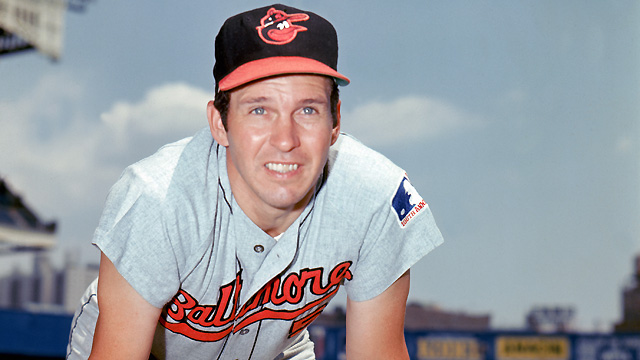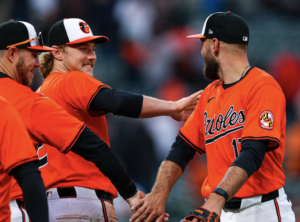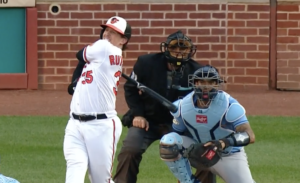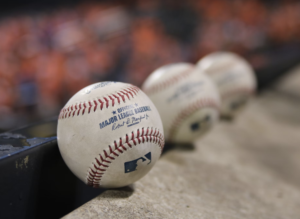The 2014 season will be a special one for the Baltimore Orioles, and not just because there are postseason dreams around Birdland. The O’s will celebrate 60 years in Baltimore, which presents the perfect opportunity to reflect on great players and memories since 1954.
In the spirit of the occasion I’ve decided to highlight some of the great individual seasons we’ve witnessed from 1954-2013. We’ve looked at left field, center field, right field, third base, shortstop, second base, first base, catcher, starting pitcher, and relief pitcher/closer.
You’ve read the cases for each player in the discussion of having the greatest season at their respective positions and have voted for who you felt had the best. Based on those results, here is the Baltimore Orioles All-Time Single Season Team.
LEFT FIELD
B.J. Surhoff , 1999
.308/.347/.492 – 104 runs, 38 doubles, 28 home runs, 107 RBI
In his age-34 season, B.J. Surhoff put together his finest of a 19-year career. In 1996, Surhoff’s first with the Orioles, he started 104 games at third base. The following year he shifted to a primary left field role and started there 145 times in 1999.
Surhoff played in all 162 games and had career-bests in runs, hits (207 – 2nd in American League), doubles, home runs, and RBI.
His 107 RBI are the most by an Oriole left fielder since 1954, as are the 207 hits. That’s also the fourth most hits by an Oriole at any position during the same time span.
Surhoff also earned his only All-Star Game appearance that year. For his efforts, he was named by local media as the Most Valuable Oriole for the 1999 season.
CENTER FIELD
Brady Anderson, 1996
.297/.396/.637 – 117 runs, 37 doubles, 50 home runs, 110 RBI, 21 stolen bases
For the second time in our series, Brady Anderson earns a spot. This time, it’s for a position and season he’s become more associated with among Orioles fans.
All Brady, and his sideburns, did in 1996 was put together the greatest offensive season for a center fielder who called Memorial Stadium or Oriole Park at Camden Yards home.
He led the American League in extra base hits (92) and finished second in home runs. Anderson was third in slugging percentage, and fourth in both total bases (369) and runs created (150).
Anderson’s .637 slugging percentage is tied for second in franchise history with Frank Robinson’s 1966 season. His 1.034 OPS is the third highest by an Oriole.
The 50 home runs stood as the franchise record until Chris Davis topped it last year. His final long ball came on the last day of the season off of Pat Hentgen, who would go on to win the Cy Young Award that year.
RIGHT FIELD
Frank Robinson, 1966
.316/.410/.637 – 122 runs, 34 doubles, 49 home runs, 122 RBI, AL MVP Award, Triple Crown
During his first year with the Baltimore Orioles, Frank Robinson made quite an impression. In his age-30 season, Robinson became the only MLB player to capture the regular season MVP in both leagues and first to claim the American League’s Triple Crown since Mickey Mantle in 1956.
Robinson led the majors in slugging percentage, OPS (1.047), total bases (367), home runs, runs created (146), extra base hits (85), and times on base (279). He paced the AL in batting average, on-base percentage, runs, and RBI.
Relative to the rest of the American League in 1966, Robinson posted an OPS+ of 198, which led the majors and is the highest for a single-season in Orioles history. He was roughly 98% more productive at the plate than the average player that season and 17% more productive than the man who finished second in OPS+. In other words, Frank Robinson was other worldly in 1966.
Of the five MVP Awards won by Oriole players, Robinson’s 130-point victory margin in 1966 is the largest.
THIRD BASE
Brooks Robinson, 1964
By this point, Brooks Robinson’s reputation as a defensive wizard at third base was well established. But in 1964, in addition to his usual stellar defense, Robinson put together his finest offensive season.
In the field, Robinson captured his fifth consecutive Gold Glove Award after leading American League third basemen in putouts (153), assists (327), double plays turned (40), and fielding percentage (.972). His 17 total zone runs were good for second.
At the plate, Brooks set career highs in hits (194 – 2nd in AL), home runs, RBI (led AL), batting average (2nd in AL), on-base percentage, and slugging percentage (6th in AL). He was also second in the league in total bases (319) and finished third in doubles and extra base hits (66).
By both the FanGraphs and Baseball Reference versions of wins above replacement (WAR), Brooks Robinson was tops among all American League position players in 1964.
SHORTSTOP
Cal Ripken Jr., 1991
.323/.374/.566 – 99 runs, 46 doubles, 34 home runs, 114 RBI, AL MVP Award, Gold Glove Award
Many of Cal Ripken’s seasons were good. A few were great. In 1991, Ripken was legendary.
Manning a premier defensive position, Ripken led the American League in total zone runs with 23. He was tops among shortstops in putouts (267), assists (528), double plays turned (114), and fielding percentage (.986). By Baseball Reference’s defensive wins above replacement (dWAR), 1991 was Cal Ripken’s second best season with the glove (behind 1984) and he was the most valuable in the field of any AL position player that year.
Offensively, Ripken led the majors in total bases (368) and extra base hits (85). He was second in the AL in slugging percentage, hits (210), doubles, and runs created (134). He was also third in OPS+ (162 – career high), fourth in home runs, and seventh in RBI.
An interesting fact: Ripken struck out just 46 times in 650 at-bats. That’s the fewest of any season he played 160+ games (15 such seasons).
When you add everything together, you have one of the finest all-around seasons ever. Ripken’s wins above replacement (WAR) in 1991 was 11.5. That’s the 11th best season for a position player in MLB history. Take out years by Babe Ruth and Barry Bonds, and it’s fourth highest behind Carl Yastrzemski (12.4 – 1967), Rogers Hornsby (12.1 – 1924), and Lou Gehrig (11.8 – 1927). Not bad company to be in.
SECOND BASE
Roberto Alomar, 1996
.328/.411/.527 – 132 runs, 43 doubles, 22 home runs, 94 RBI, 17 stolen bases, Gold Glove Award
Thus far in the series, we’ve seen a few seasons by players in their first year with the Orioles (Frank Robinson, B.J. Surhoff, and Miguel Tejada). Roberto Alomar now joins that list.
In 1996, Alomar had the best offensive season of any Orioles second baseman since 1954. His hits (193), home runs, runs scored, RBI, batting average, on-base percentage, and slugging percentage are all tops for a single-season among those who have played the position.
Alomar was third in the American League in runs, sixth in hits, seventh in average and doubles, and eighth in times on base (284).
He also took home his sixth consecutive Gold Glove Award and second Silver Slugger Award.
FIRST BASE
Chris Davis, 2013
.286/.370/.634 – 103 runs, 42 doubles, 53 home runs, 138 RBI
Orioles’ playoff run in 2012. The following year, Crush took Major League Baseball by storm and finished third in AL MVP Award voting.
Davis led the majors in total bases (370), home runs, RBI, and extra base hits (96). He was second in the American League in slugging percentage and runs scored. Davis was also third in OPS+ (165) and doubles.
Since 1954, Davis’ 370 total bases are the most by an Oriole and are second in franchise history to George Sisler’s 399 in 1920. His 53 home runs and 96 extra base hits both surpassed marks set by Brady Anderson in 1996 (50 and 92 respectively) to establish new club records.
And, Davis was third among AL first basemen with a .996 fielding percentage.
CATCHER
Chris Hoiles, 1993
.310/.416/.585 – 80 runs, 28 doubles, 29 home runs, 82 RBI
Chris Hoiles spent his entire 10-year major league career with the Baltimore Orioles after being part of the trade that sent Fred Lynn to the Detroit Tigers. In 1993, Hoiles put together the best season of his career and one of the best for an O’s backstop.
Hoiles led the team in home runs and OPS+ (162), and was second in RBI, walks (82), batting average, and total bases (245). His on-base and slugging percentages were also tops on the team and both rank as the highest for a single-season since 1954 among Oriole catchers. Hoiles’ .310 average is second to the .316 Javy Lopez posted in 2004 (see below).
Hoiles caught 41% of attempted base stealers in 1993, the highest mark of his career. The American League average that year was 36%.
STARTING PITCHER
Jim Palmer, 1975
23-11, 2.09 ERA, 1.03 WHIP, 323 innings, 193 strikeouts, 25 complete games, 10 shutouts, AL Cy Young Award
Jim Palmer was a six-time All-Star, won four Gold Glove Awards, and tossed a no-hitter. He also won three American League Cy Young Awards in a span of four years. 1975 was one of those years.
Palmer led the majors in ERA, wins, and shutouts. His ERA+, which adjusts for ballpark factors and league averages, of 169 was also good for first. In the American League, Palmer was second in innings pitched and complete games, third in hits per nine innings (7.1), and fourth in strikeouts.
By both the Baseball Reference and FanGraphs versions of wins above replacement (WAR), Palmer’s 1975 tops the list as the best season ever by an Orioles pitcher. The 10 shutouts are most in franchise history and Palmer’s 323 innings pitched are most by an Oriole since 1954.
RELIEF PITCHER
Jim Johnson, 2012
71 games, 2-1, 2.49 ERA, 1.02 WHIP, 68.2 innings, 41 strikeouts, 51 saves
In his first full season as the Orioles’ closer, Jim Johnson set a new franchise record, made his lone All-Star team, and finished seventh in American League Cy Young voting.
Johnson’s 51 saves led the majors and surpassed the previous team record set by Randy Myers in 1997. He became the 10th player in MLB history to top the 50-save plateau.
An ERA+ of 170 placed Johnson fourth among AL relievers with 20+ saves (13 pitchers).









